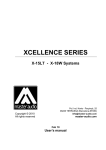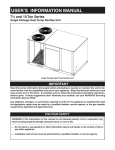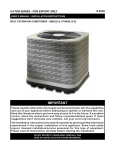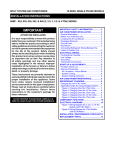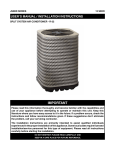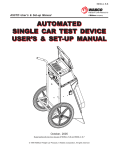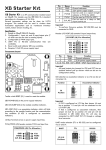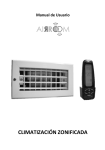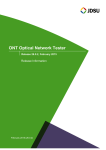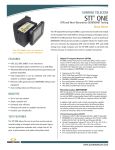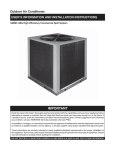Download 708760-A Q6SP-090-120 Series User manual.indd
Transcript
Q6SP-090 (7 1/2) & -120 (10 Ton) Series USER’S MANUAL Single Package Heat Pump Rooftop Unit IMPORTANT! Please read all information in this manual thoroughly and become familiar with the capabilities and use of your appliance before attempting to operate or maintain this unit. Pay attention to all safety warnings and any other special notes highlighted in the manual. Safety markings are used frequently throughout this manual to designate a degree or level of seriousness and should not be ignored. WARNING indicates a potentially hazardous situation that if not avoided, could result in personal injury or death. CAUTION indicates a potentially hazardous situation that if not avoided, may result in minor or moderate injury or property damage. Keep this literature where you have easy access to it in the future. If a problem occurs, check the instructions and follow recommendations given. If these suggestions don’t eliminate your problem, call your servicing contractor. Do not attempt to service this unit yourself! Q6SP-090 Shown ! WARNING: • Under no circumstances should the appliance owner attempt to install and/or service this equipment. Some local codes require licensed installation / service personnel for this type of equipment. Improper service, adjustment, or maintenance may cause explosion, fire, electrical shock or other hazardous conditions which may result in personal injury or property damage. • Read these instructions thoroughly before using the equipment. Follow all precautions and warnings contained within these instructions and on the unit. • Improper installation, adjustment, alteration, service, or maintenance can cause personal injury or property damage. Refer to this manual. For assistance or additional information, consult a qualified installer or service agency. • Do not store or use gasoline or other flammable vapors and liquids in the vicinity of this or any other appliance. DO NOT DESTROY. PLEASE READ CAREFULLY AND KEEP IN A SAFE PLACE FOR FUTURE REFERENCE. ABOUT THE HEAT PUMP Your heat pump is a unique, all weather comfort-control appliance that will heat and cool your building year round and provide energy saving comfort. It’s an unknown fact that heat is always in the air, even when the outside temperature is below freezing. The heat pump uses this basic law of physics to provide energy saving heat during the winter months. For example, If the outdoor temperature is 47° F (8° C), your heat pump can deliver approximately 3.5 units of heat energy per each unit of electrical energy used, as compared to a maximum of only 1 unit of heat energy produced with conventional heating systems. In colder temperatures, the heat pump performs like an air conditioner run in reverse. Available heat energy outside the building is absorbed by the refrigerant and exhausted inside. This efficient process means you only pay for “moving” the heat from the outdoors to the indoor area. You do not pay to generate the heat, as is the case with more traditional furnace designs. During summer, the heat pump reverses the flow of the heat-absorbing refrigerant to become an energy-efficient, central air conditioner. Excess heat energy inside the home is absorbed by the refrigerant and exhausted outside the building. IMPORTANT SAFETY INFORMATION WARNING: To avoid possible equipment damage, fire, or personal injury, the following instructions must be observed regarding unit maintenance and operational procedures. The Q6SP Series package heat pump rooftop unit has been designed and built to provide many years of safe and dependable comfort, providing it is properly installed and maintained. With regular maintenance, this unit will operate satisfactorily year after year. Abuse, improper use, and/or poor maintenance can shorten the life of the appliance and create unsafe hazards. A regular service and maintenance schedule should be established to ensure efficient and safe operation of the unit. See System Maintenance on page 3. • To achieve optimum performance and minimize equipment failure, it is recommended that periodic maintenance be performed on this unit. The ability to properly perform maintenance on this equipment requires certain mechanical skills and tools. • The area around the unit and the vicinity of any other appliances must be kept clear and free of combustible materials, gasoline, and other flammable vapors and liquids. Do not store or use flammable items such as paint, varnish, or strippers in the vicinity of the unit. • Do not use the area around the unit as a storage area. This area must be kept clean and clear of loose or 2 • • • • exposed insulation materials. Examine the unit’s area when it is installed or when insulation is added, since some insulation materials may be combustible. Do not use this appliance if any part has been under water. Immediately call a qualified service technician to inspect the unit and to replace any part of the electrical control system that has been under water. Familiarize yourself with the controls that shut off the electrical power to the unit. If the unit is to be shut down for an extended period of time, turn off the electrical power. For your safety always turn off the electrical power before performing service or maintenance on the furnace. Do not block or obstruct air openings on the unit or air openings supplying the area where it is installed. The duct connections must be physically sound and sealed to the unit’s casing. The return air and circulating air ductwork must not be connected to any other heat producing device such as a fireplace insert, stove, etc. Improperly installed ductwork may result in fire, explosion, personal injury, carbon monoxide poisoning, or property damage. OPERATING INSTRUCTIONS Thermostat styles vary. Some models may not include the AUTO mode and others will have the AUTO in place of the HEAT and COOL. Others may include all three. Some thermostats may have anti-short cycle protection built in causing a delay in one or both stages. A protective timer circuit may hold the compressor(s) off for up to 5 minutes following a previous operation or an interruption of the main power. Please refer to the thermostat’s User Manual for detailed programming instructions. The thermostat should be mounted about 5 feet above the floor on an inside wall and not on an outside wall or other location where its operation may be adversely affected by radiant heat from fireplaces, sunlight, or lighting fixtures, and convective heat from warm air registers or electrical appliances. Cooling Operation 1. Set the thermostat system mode to COOL and the thermostat fan mode to AUTO (See Figure 1, page 3). 2. Set the thermostat temperature selector to the desired temperature level. The outdoor fans, compressors, and indoor blower will all cycle on and off to maintain the indoor temperature at the desired cooling level. NOTE: This unit is equipped with a five minute antishort cycle timer (ASCT) built in to the defrost control board for Stage 1 Heat or Cool. If the thermostat temperature level is re-adjusted, or if the system mode is changed, the compressor may not start immediately. Stage 2 Heat/Cool has no ASCT protection and can operate immediately upon a call from the thermostat. Heating Operation (2 or 3 Stage) 2 individual refrigerant systems + Electric Heat (if installed) 1. Set the thermostat system mode to Heat and the thermostat fan mode to AUTO (See Figure 1). 2. Raise the thermostat temperature switch above room temperature and observe that the outdoor fans, compressor(s), and indoor blower all cycle on and off. NOTES: • This unit is equipped with a 5 minute anti-short cycle timer (ASCT) built into the defrost control board for Stage 1 Heat or Cool. If the thermostat temperature level is re-adjusted, or if the system mode is changed, the compressor may not start immediately. Stage 2 Heat/Cool has no ASCT protection and can operate immediately upon a call from the thermostat. • If electric heat has been installed, the Stage 2 compressor will cycle off while Stage 3 heater elements cycle on. Emergency Heat Most heat pump thermostats will include a system mode called EM.HT. or AUX.HT, etc. This is a back-up heating mode that should only be used only if a problem is suspected. With the system switch set to Emer. Ht., etc., the compressor(s) and outdoor fans will be locked off and supplemental heat (electric resistance heating) will be used as a source of heat. Sustained use of electric resistance heat in place of the heat pump will result in an increase in electric utility costs. Defrost Mode During cold weather heating operation, the outdoor unit will develop a coating of ice and frost on the outdoor heat transfer coil. This is normal and the unit will defrost itself automatically. During the defrost cycle, the outdoor fans will stop while the compressor(s) continue to operate and heat the outdoor coil, causing the ice and frost to melt. During defrost, some steam may rise from the outdoor unit as the warm coil causes the melted frost to evaporate. Operating the Indoor Blower Continuously Continuous indoor blower operation is typically used to circulate the indoor air to equalize a temperature imbalance due to solar loads, occupancy loads, or mechanical equipment operation. Set the thermostat fan mode to ON (or CONT on some thermostat models). The indoor blower will start immediately, and run continually until the fan switch is reset to AUTO. NOTE: The continuous indoor blower operation can be obtained with the thermostat system switch set in any position, including OFF. System Shutdown Set the thermostat system mode to OFF and the thermostat fan mode to AUTO. See Figure 1. NOTE: The system will not operate, regardless of the thermostat temperature selector’s setting. System Mode Fan Mode Temperature Selector Figure 1. Digital Thermostat UNIT MAINTENANCE WARNING: Verify all electrical power to the unit is shut off before performing the following recommended maintenance. Proper maintenance is most important to achieve the best performance from the appliance and should be performed by a qualified service technician at least once a year. Follow the maintenance schedule and the instructions below for years of safe, trouble free operation. • Do not place combustible materials on or against the cabinet. Do not store gasoline or any other flammable vapors and liquids in the vicinity of the unit. • Annually inspect the physical support of the unit to ensure that it is physically sound without sagging, cracks, gaps, etc., around the base so as to provide a seal between the support and the base. • Annually inspect the return-air connection to ensure that it is physically sound and is still sealed to the casing of the unit. Also inspect the unit, ductwork, and vent system for signs of physical deterioration. • Always replace the doors on the unit after servicing. Do not operate the unit without all doors and covers in place. Avoid operating the unit when windows and doors are open. Regular Cleaning WARNING: DO NOT touch any of the internal electrical components while cleaning the unit. • Remove any debris from the outdoor coil Being careful not to damage the aluminum fins. • Inspect the condensate drain at the beginning of each cooling season. Remove any debris. • Clean the blower compartment regularly during the heating and cooling seasons to remove any dust that may have accumulated in the compartment or on 3 the blower and motor. Buildup of dust on the blower and motor can create excessive loads on the motor resulting in higher than normal operating temperatures and possible shortened service life. Motor Lubrication The motors for the circulating air blower and outdoor fan are pre-lubricated and sealed by the manufacturer. No further oiling is required for the life of this product. TROUBLESHOOTING Air Filters WARNING: Never operate the unit without a filter in the return air system. Dust and lint in the return air can build up on the internal components, resulting in loss of efficiency, equipment damage, and possible fire risk. • Q6SP Series units are factory equipped with pleated 2 inch disposable filters. The filters should be checked periodically and replaced (or cleaned) when necessary with filters of the same dimensional size. Replace using disposable filters with a minimum airflow rating of 500 FPM or permanent filters only. • The filter rack is field adjustable to accommodate 1” permanent filters. DO NOT use 1” disposable filters in these units. • Always replace the filter access panels after changing or cleaning the filters. DO NOT operate unit without the filter access panels in place. • It is very important to replace or clean the filter(s) installed in the return air duct of this system. A clogged filter could cause airflow related problems and reduce the overall efficiency of your unit. Always replace disposable filter(s) installed in your system only with the same size dimensional filters that are being replaced. • Filters must be ULC approved or equivalent for use in Canada. Before you call a Technician, check the following: • Check the thermostat setting. Make sure the system mode and temperature settings are correct. • Check the electrical panel for tripped circuit breakers. • Check the filters for dust accumulation. • If the items above don’t resolve your problems, then call your nearest service technician. WARRANTY INFORMATION A warranty certificate with full details is included with the equipment. Carefully review these responsibilities with your dealer or service company. The manufacturer will not be responsible for any costs found necessary to correct problems due to improper setup, improper installation, adjustments, improper operating procedure on the part of the user, etc. Some specific examples of service calls which are not included in the limited warranty are: • Correcting wiring problems in the electrical circuit supplying the equipment. • Resetting circuit breakers or other switches. • Adjusting or calibrating of thermostat. ¢708760.¤ Specifications & illustrations subject to change without notice or incurring obligations. O' Fallon MO | Printed in U.S.A. (12/10) 708760A (Replaces 7087600)




